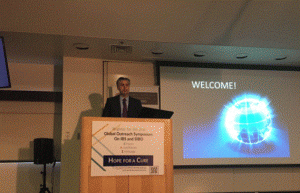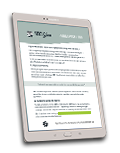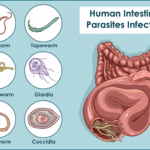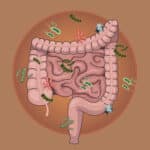SIBO Symposium 2016 -Cedar Sinai Summary

In the interest of sharing, I thought I would share my notes from the conference:
48 million people suffer from IBS in the United States, but only 10-12 million are diagnosed. IBS affects 1 billion worldwide.
IBS was originally labeled ‘spastic colon’ in the 1950’s, but changed to IBS in the 1970’s.
In the 1980’s Rome Criteria was created to try to help with the diagnosis of this condition, yet, when assessing the list: abdominal discomfort, diarrhea or constipation and secondary are urgency, incomplete evacuation and relief of pain with bowel movement… these symptoms really cover too many conditions.
IBS has become a diagnosis of exclusion. People are put through a battery of expensive and invasive tests (that carry their own risk factors) to exclude other conditions before settling on IBS as a diagnosis. These include endoscopy, colonoscopy, and various scans.
At the present time, the Rome Criteria for IBS still does not include bloating. Clinically, bloating is the number one symptom that IBS/ SIBO patients complain about.
60% of IBS is really SIBO. SIBO is NOT a diagnosis. It is a secondary condition that is caused by something else that has interfered with motility in the small intestine.
The body prevents SIBO from occurring by producing stomach acid, bile and liver juices (which all act as antibiotics, clearing organisms from the food and matter that is moving through our digestive tract), forward flow of matter through the digestive tract, and the immune system tags foreign material for waste and helps beneficial flora form robust biofilms.
A new 2016 Australian study shows that stress triggers IBS, but IBS drives anxiety (which feeds back and makes symptoms worse).
"Get the latest updates from the SIBO Outreach Symposium #SIBOIBS16 with SIBO Guru"
↑ Tweet ThisGas production – hydrogen and methane gases are not made by us. They are made by our microbiome. We can use this as a biomarker.
Breath testing – if on a PPI (proton pump inhibitor) no need to stop this during the testing phase. Pull laxatives for one week prior to the test. If doing a breath test after successful treatment, to reconfirm successful treatment, then wait four weeks post antibiotics. If testing during treatment, to assess efficacy of treatment, test 2 weeks post antibiotics (I’m adding 5 days post herbal antibiotics).
Using Breath Test to test oral-cecal transit time – no need to. Assess rise in gases from baseline to 90 minute mark. If suspect fructose, lactose or sucrose intolerance, first do SIBO lactulose breath test to rule out SIBO, then do the other tests.
Single Spot Breath Test. They are studying whether simply testing one marker (baseline) for methane is as effective at testing over a three hour test. They are finding that it is (I do take issue with this- in my training, if baseline is elevated, then we should be looking to colonic dysbiosis and perhaps not SIBO).
If hydrogen is elevated at baseline, they feel that this may be a different kind of hydrogen that has not yet been identified (not hydrogen sulfide).
They are working on a hydrogen sulfide breath test.
FMT (fecal microbial transplant) – use caution if IC valve integrity is in question.
It takes bacteria 20-30 minutes to start to produce gases at a level we will detect on the test.
LDN (low dose naltrexone) is being used with some of their patients (this can be a light prokinetic and also helps pain management, fatigue, endurance).
2 liters of stomach acid are produced each day. Can’t really replace this with HCL Betaine capsules.
NEW there is an international consensus that has discussed diagnostic guidelines for gas production. This consensus suggests 10ppm methane is considered positive for methane (up from 3ppm previously and still recommended by Dr. Pimentel’s group).
The placenta has its own microbiome.
Polysorbate 80 was tested in germ free mice (without microbiota) and in mice with microbiota – in mice with microbiota, this emulsifier increased fat pads and blood glucose, changes in insulin clearance and changes in liver enzymes.
1:10 chance that when you get food poisoning, you will get SIBO. Women are at higher risk. When mice were given post infectious IBS (SIBO from food poisoning) the level of SIBO present, was in direct correlation with the level of food poisoning (toxin administered) in the middle part of the small intestine (the jejunum). There was NO change to colonic organisms. This is only occurring in the small intestine.
They have tried creating a CDT-b toxin (toxin from food poisoning) vaccine, but so far, it is not working.
Histamine and SIBO – bacteria and some food = histamine release.
Everyone with SIBO should have IBS Check test to confirm why SIBO is present. Even if a food poisoning event is not recollected, event can be asymptomatic.
If IBS Check test is positive – can treat and not go down the route of endoscopy, colonoscopy, scans, etc.
Adhesions from endometriosis and appendicitis can cause SIBO (add to this ovarian cysts rupturing too). They tether the small intestine and stop the conduction/ movement of migrating motor complex waves down the small intestine.
Ehlers Danlos Syndrome –hypermobility – bowels can actually prolapse and drop into pelvic floor.
LDE (lose dose erythromycin) generates waves from the antrum down. Prucalopride generates waves from the duodenum down. LDE interactions – with statins, antipsychotic medications and over time, people can become less responsive to LDE. They state that LDE is such a low dose that it doesn’t change diversity and it increases motility, so this may ameliorate the risk (I do wonder though – the effects on motility can be short lived. Many people find that LDE stops working over time, so then we are left with a LOW dose antibiotic being used for up to 60 months post treatment. We are still dumping an antibiotic into our environment (internal and external) and I have a hard time swallowing that this is without risk.
DUI conviction?? Can’t blame SIBO. Cedar Sinai worked with LAPD to test this, and SIBO does not cause a false positive on a breathalyzer.
Betaine HCL and vinegars, make fuel methanogens (they can use acid as fuel).
Antibiotics and obesity – can overlay map of America with highest incidence of antibiotic use and it lines up with obesity map. If mom had antibiotics (ABX) while pregnant, 84% risk of obesity in child. If kill some microbiome, obesity risk goes up. Low dose antibiotics are used in animal feed to fatten them up. If child has 4 or more antibiotic rounds 0-6 months, 47% increased risk of obesity.
If add methane gas into small intestine, transit time slows by 69%. Rate of slowing is directly proportional to the amount of methane gas added.
Lovastatin (time released) is now in phase III trials – this is showing promise by interfering with methanogens ability to take up hydrogen to make methane (they use 4 hydrogen to make one methane).
Cedar Sinai also mentioned Pyridostigmine (a parasympathomimetic and a reversible cholinesterase inhibitor) as a valgus nerve stimulator.
Probiotics- I was a bit disappointed with the discussion on probiotics. Bacillus coagulans has very good studies, specifically on IBS and they didn’t discuss this. They chose to highlight a few studies on other probiotics that had no effect, then they shared a study about probiotics given to acute pancreatitis patients and 14 who of whom died abruptly. It is true, in cases of infection (ulcerative colitis, pancreatitis, sepsis) – probiotics should not be used. There are over 17,000 studies on probiotics on Pubmed.gov (peer reviewed studies and case studies). Probiotics are well tested and show benefits in many conditions.
Anti-vinculin – increased antibodies can increase risk of scleroderma (being studied).
They mentioned a new treatment on the horizon – this would be for those who have a positive IBS Check test and positive vinculin antibodies. The procedure is called plasmapheresis and this process strips out ALL antibodies from the blood. Motility inhibition was restored in their test case for one month and then the body started to rebuild its antibody reserves once again. This seems quite invasive and places the patient at risk for a lot of other issues (creates an immunosuppressed environment). I doubt that this will be a treatment implemented anytime soon.
A special thank you to Dr. Pimentel and his staff and the doctors at Cedar Sinai for hosting this symposium.
Enjoying this content? Sign up for updates... It's FREE!

















